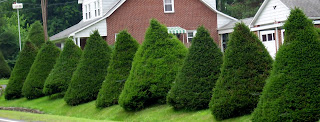 |
| Zig Zag Fences With Plants To Embellish |
Types and Examples Of Garden Fences
Fencing can be a beautiful piece of art. Wrought Iron is made in many sizes and contours. Wood Fences can be painted any color you wish and have various tops you can choose from. They can be as simple as a picket fence to as private as a Stockade type of fence. Oh and we cannot forget the beautiful stone fences you see around the countryside.


 |
| Evergreen Border Fence |
 |
| Spruce Privacy Fencing |
Man-Made Fencing
.JPG) |
| Stockade Fence |
 |
| Picket Fence and backside of a Stockade Fence |
 |
| Split Rail Fence |
 |
| Wooden with Wire Fence |
Video about Planting A Living Fence
Living Fences
These are the most decorative and yet functional fences that
I have seen. You can have them
structured or supported on another type of fence or you can have them stand
alone. Trees and hedges are used as stand-alone fences to divide your property
up or enclose it for privacy. They can
be a creative as you can imagine.
Some plants that make great stand-alone living fences
include: Boxwoods, Forsythia, Poplar
Trees, Spruce Trees, any dwarf trees such as Dwarf Burning Bush, Bush-type
Roses, Butterfly Bushes, Privet hedges, Douglas Fir, Spireas, Siberian Elm and
lots more. These have no need for support.
There are so many plants that you can use for supported
fences these days. You can have fruits
and vegetables to flowing vines and non-flowering vines. You will have many birds and small animals
live, grow and reproduces in these.
Nature will astound and abound in these fences.
Some Plants That You Can Use
 |
| Grapes. Plant a crop of low growing vegetables under the gaps of the grapes |
 |
| Blackberries or other climbing, vine-like fruits for a thick fence for all to enjoy. |
 |
| These Tomatoes grew way taller than this could handle and would be a good crop along a 4-6 tall fence. |
Vegetables that you can also grow on fences are: Zucchini, Cucumbers,
Tomatoes, Beans and Peas, Cantaloupes and small varieties of melons, Gourdes
too and the selections of these are almost endless.
 |
| Mandevilla |
 |
| Boston Ivy |
Your fence does not have to be plain or drab. With the many ways that I have listed here you
can have color, food and functionality all at the same time. You can even mix them up. Vegetables have beautiful flowers too and can be grown with other flowering or non flowering plants.
Bushes such as: burning bushes, plus lilac and rhododendron also are a nice natural fence
Bushes such as: burning bushes, plus lilac and rhododendron also are a nice natural fence
 |
| Block and Boards Fence Blocks and Boards put int the holes of the Cinder Blocks. Blocks are painted a Brick Color. No Need To Bury Posts! |
For More Fences please visit my article for Fences for Animals
What creative ways are you going to incorporate into your borders?
© Debra K. Allen
a.k.a Lady Guinevere
I researched
and wrote this article. Please do not copy and paste any part of this article,
picture included for your own use. I will find you and report you for stealing.
It is my right to change any information
therein at any time and/or change the location of my article.





























